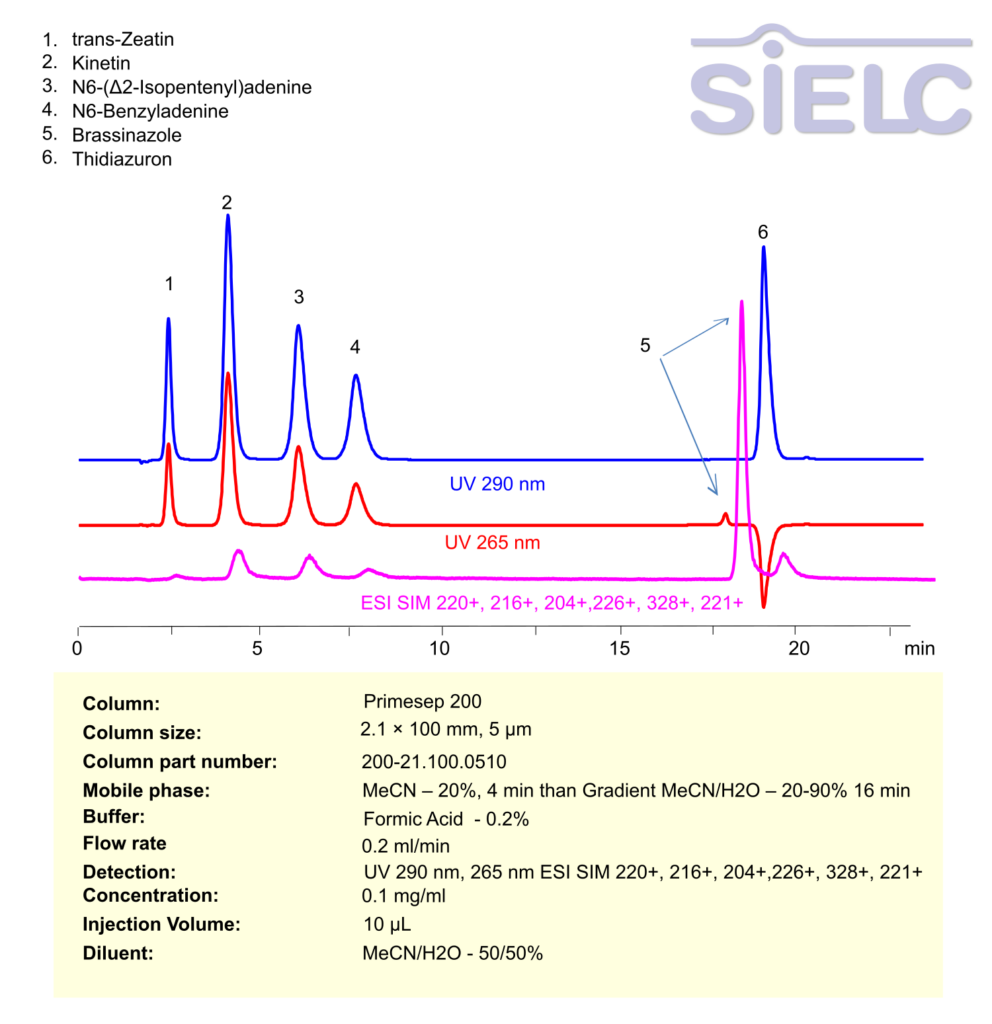High Performance Liquid Chromatography (HPLC) MS Method for Analysis of trans-Zeatin, Kinetin, N6-(Δ2-Isopentenyl)adenine, Thidiazuron, 6-Benzylaminopurine, Brassinazole on Primesep 200 by SIELC Technologies
Separation type: Liquid Chromatography Mixed-mode SIELC Technologies

High Performance Liquid Chromatography (HPLC) Method for Analysis of trans-Zeatin, Kinetin, N6-(Δ2-Isopentenyl)adenine, Thidiazuron, 6-Benzylaminopurine, Brassinazole
It looks like you’re listing a series of compounds, most of which are cytokinins or related plant hormones. Here’s a brief overview and classification for the compounds you mentioned:
trans-Zeatin:
- A type of cytokinin.
- Naturally occurring in plants and plays a key role in promoting cell division and growth.
Kinetin:
- A synthetic cytokinin.
- Used in plant tissue culture to stimulate cell division.
N6-(Δ2-Isopentenyl)adenine (iP):
- Another cytokinin.
- Found in plants and is involved in regulating growth, development, and differentiation.
N6-Benzyladenine (BA):
- A synthetic cytokinin.
- Commonly used in agricultural practices to enhance plant growth and delay senescence.
Brassinazole:
- Not a cytokinin, but a brassinosteroid biosynthesis inhibitor.
- Used to study the role of brassinosteroids (another class of phytohormones) in plants.
Thidiazuron (TDZ):
- A phenylurea derivative that acts as a cytokinin-like compound.
- Widely used in plant tissue culture to promote shoot regeneration and induce cytokinin-like effects.
trans-Zeatin, Kinetin, N6-(Δ2-Isopentenyl)adenine, Thidiazuron, 6-Benzylaminopurine, Brassinazole can be retained, separated and analyzed using a Primesep 200 mixed-mode stationary phase column. The analysis employs an isocratic method with a simple mobile phase comprising water, acetonitrile (MeCN), and formic acid as a buffer. This method allows for detection using UV 290, 265 nm.
You can find detailed UV spectra of trans-Zeatin, Kinetin, N6-(Δ2-Isopentenyl)adenine, Thidiazuron, 6-Benzylaminopurine, Brassinazole and information about its various lambda maxima by visiting the following link.
| Column | Primesep 200, 2.1 x 100 mm, 5 µm, 100 A, dual ended |
| Mobile Phase | MeCN – 20%, 4 min than Gradient MeCN/H2O – 20-90% 16 min |
| Buffer | Formic Acid -0.2% |
| Flow Rate | 0.2 mg/ml |
| Detection | UV 290 nm, 265 nm ESI SIM 220+, 216+, 204+,226+, 328+, 221+ |
| Class of Compounds | Phytohormone |
| Analyzing Compounds | trans-Zeatin, Kinetin, N6-(Δ2-Isopentenyl)adenine, Thidiazuron, 6-Benzylaminopurine, Brassinazole |
Application Column
Primesep 200
Column Diameter: 2.1 mm
Column Length: 100 mm
Particle Size: 5 µm
Pore Size: 100 A
Column options: dual ended
Brassinazole
Kinetin
N6-(Δ2-Isopentenyl)adenine
Thidiazuron
trans-Zeatin
LC MS Detection





